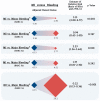Trade-off of myocardial infarction vs. bleeding types on mortality after acute coronary syndrome: lessons from the Thrombin Receptor Antagonist for Clinical Event Reduction in Acute Coronary Syndrome (TRACER) randomized trial
- PMID: 28363222
- PMCID: PMC5837470
- DOI: 10.1093/eurheartj/ehw525
Trade-off of myocardial infarction vs. bleeding types on mortality after acute coronary syndrome: lessons from the Thrombin Receptor Antagonist for Clinical Event Reduction in Acute Coronary Syndrome (TRACER) randomized trial
Abstract
Aims: Dual antiplatelet therapy reduces non-fatal ischaemic events after acute coronary syndrome (ACS) but increases bleeding to a similar extent. We sought to determine the prognostic impact of myocardial infarction (MI) vs. bleeding during an extended follow-up period to gain insight into the trade-off between efficacy and safety among patients after ACS.
Methods and results: In 12 944 patients with non-ST-segment elevation ACS from the Thrombin Receptor Antagonist for Clinical Event Reduction in Acute Coronary Syndrome (TRACER) trial, we investigated the relative impact of MI and bleeding occurring >30 days post-ACS and subsequent all-cause mortality. Bleeding was graded according to Bleeding Academic Research Consortium (BARC) criteria. MI was associated with a five-fold increase in mortality. BARC type 2 and 3, but not type 1, bleeding had a significant impact on mortality. MI was associated with a greater risk of mortality compared with BARC 2 [relative risk (RR) 3.5; 95% confidence interval (CI) 2.08-4.77; P < 0.001] and BARC 3a bleeding (RR 2.23; 95% CI 1.36-3.64; P = 0.001), and a risk similar to BARC 3b bleeding (RR 1.37; 95% CI 0.81-2.30; P = 0.242). Risk of death after MI was significantly lower than after BARC 3c bleeding (RR 0.22; 95% CI 0.13-0.36; P < 0.001). MI and bleeding had similar time-associations with mortality, which remained significant for several months, still being higher early after the event.
Conclusion: In patients treated with antiplatelet therapy after ACS, both MI and bleeding significantly impacted mortality with similar time-dependency. Although BARC 2 and 3a bleeding were less prognostic for death than MI, the risk of mortality was equivalent between BARC 3b bleeding and MI, and was higher following BARC 3c bleeding.
Keywords: Acute coronary syndrome; Bleeding; DAPT; Myocardial infarction.
Published on behalf of the European Society of Cardiology. All rights reserved. © The Author 2016. For Permissions, please email: journals.permissions@oup.com.
Figures



Comment in
-
First, do no (irreparable) harm: infarction, bleeding, and subsequent risk of death. The dangers of false equivalency.Eur Heart J. 2017 Mar 14;38(11):811-813. doi: 10.1093/eurheartj/ehw639. Eur Heart J. 2017. PMID: 28363223 No abstract available.
References
-
- Yusuf S, Zhao F, Mehta SR, Chrolavicius S, Tognoni G, Fox KK.. Effects of clopidogrel in addition to aspirin in patients with acute coronary syndromes without ST-segment elevation. N Engl J Med 2001;345:494–502. - PubMed
-
- Wiviott SD, Braunwald E, McCabe CH, Montalescot G, Ruzyllo W, Gottlieb S, Neumann FJ, Ardissino D, De Servi S, Murphy SA, Riesmeyer J, Weerakkody G, Gibson CM, Antman EM.. Prasugrel versus clopidogrel in patients with acute coronary syndromes. N Engl J Med 2007;357:2001–2015. - PubMed
-
- Wallentin L, Becker RC, Budaj A, Cannon CP, Emanuelsson H, Held C, Horrow J, Husted S, James S, Katus H, Mahaffey KW, Scirica BM, Skene A, Steg PG, Storey RF, Harrington RA.. Ticagrelor versus clopidogrel in patients with acute coronary syndromes. N Engl J Med 2009;361:1045–1057. - PubMed
-
- Becker RC, Bassand JP, Budaj A, Wojdyla DM, James SK, Cornel JH, French J, Held C, Horrow J, Husted S, Lopez-Sendon J, Lassila R, Mahaffey KW, Storey RF, Harrington RA, Wallentin L.. Bleeding complications with the P2Y12 receptor antagonists clopidogrel and ticagrelor in the PLATelet inhibition and patient Outcomes (PLATO) trial. Eur Heart J 2011;32:2933–2944. - PubMed
-
- Rao SV, O'Grady K, Pieper KS, Granger CB, Newby LK, Van de Werf F, Mahaffey KW, Califf RM, Harrington RA.. Impact of bleeding severity on clinical outcomes among patients with acute coronary syndromes. Am J Cardiol 2005;96:1200–1206. - PubMed
Publication types
MeSH terms
Substances
LinkOut - more resources
Full Text Sources
Other Literature Sources
Medical

